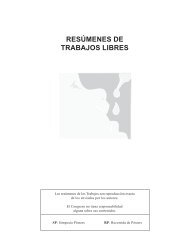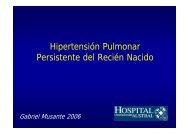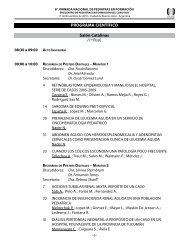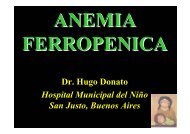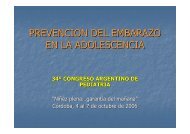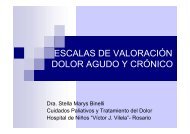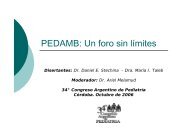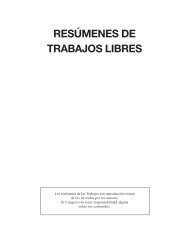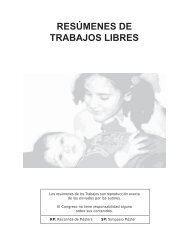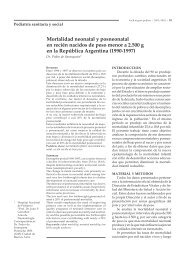Perinato.T libres - Sociedad Argentina de PediatrÃa
Perinato.T libres - Sociedad Argentina de PediatrÃa
Perinato.T libres - Sociedad Argentina de PediatrÃa
Create successful ePaper yourself
Turn your PDF publications into a flip-book with our unique Google optimized e-Paper software.
<strong>Sociedad</strong> <strong>Argentina</strong> <strong>de</strong> Pediatría<strong>Sociedad</strong> <strong>de</strong> Obstetricia y Ginecología <strong>de</strong> Buenos AiresPATOLOGÍAS PLACENTARIAS Y SU RELACIÓNCON LESIONES DE LA SUSTANCIA BLANCAPERIVENTRICULAR EN RECIÉN NACIDOS DEMUY BAJO PESO DENTRO DE LAS 72 HS DE VIDASP 219Balanian N. 1 ; Mazzitelli N. 2Hospital Materno Infantil Ramón Sardá 1,2INTRODUCCIÓN:Las lesiones <strong>de</strong> la sustancia blanca periventricular (LSBPV) son la principal causa <strong>de</strong>parálisis cerebral en preterminos y muchas <strong>de</strong> ellas son <strong>de</strong> origen prenatal. Las patologíasplacentarias pue<strong>de</strong>n asociarse a LSBPV y pronóstico neurológico adverso.OBJETIVO:Evaluar la relación entre las patologías placentarias (PP) y la aparición <strong>de</strong> LSBPV <strong>de</strong>ntro<strong>de</strong> las 72 hs <strong>de</strong> vida.POBLACIÓN:Se incluyeron todos los RN con peso entre 500 y 1500 g y menos <strong>de</strong> 32 semanas <strong>de</strong>gestación admitidos en la unidad <strong>de</strong> cuidados intensivos neonatales entre el 4/02 y el10/04. Se excluyeron los RN con síndromes genéticos, malformaciones cerebrales oinfecciones intrauterinas específicas.MÉTODOS:Se realizó ecografía cerebral <strong>de</strong>ntro <strong>de</strong> las primeras 72 hs <strong>de</strong> vida y estudio histopatológicoplacentario. Las PP fueron clasificadas en:1) inflamación (corioamnionitis aguda /vasculitis aguda corial y umbilical),2) vasculopatía materno-fetal,3) ambas lesiones. Se diagnosticó LSBPV cuando se observó: leucomalacia periventricular,infarto hemorrágico periventricular, dilatación ventricular, eco<strong>de</strong>nsida<strong>de</strong>speriventriculares o hiperecogenicidad parenquimatosa. Los factores <strong>de</strong> confusión parael análisis multivariado incluyeron género, RCIU, corticoi<strong>de</strong>s prenatales, rotura prematura<strong>de</strong> membranas (RPM) y embarazo múltiple.RESULTADOS:Se incluyeron 139 pacientes <strong>de</strong> los cuales 38 (27%) presentaron LSBPV. Los pacientescon PP tuvieron menor edad gestacional y mayor frecuencia <strong>de</strong> RPM que aquellos sinPP. Cuando ambos grupos <strong>de</strong> PP se hallaron presentes la relación entre PP y LSBPV fueestadísticamente significativa por análisis univariado (OR: 5,7, 95% CI: 1,65-19,4) y poranálisis multivariado (OR: 4,4, 95% CI: 1,1-17,8). La vasculopatía se asoció también enel análisis multivariado con LSBPV (OR: 5.8, 95% CI: 1,6-20.3). La especificidad <strong>de</strong> PPpara LSBPV fue <strong>de</strong>l 95%, con un valor predictivo negativo (VPN) <strong>de</strong>l 80%.CONCLUSIONES:La patología placentaria (inflamación/vasculopatía materno-fetal) se asoció con LSBPV<strong>de</strong>ntro <strong>de</strong> las primeras 72 hs <strong>de</strong> vida con alta especificidad y VPN. No hallamos asociaciónsignificativa entre inflamación placentaria y LSBPV. La examinación placentariapue<strong>de</strong> sugerir el origen prenatal <strong>de</strong> las LSBPV.• 130 •



